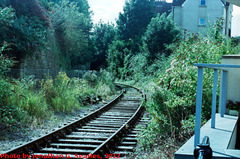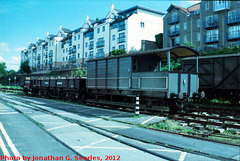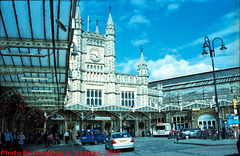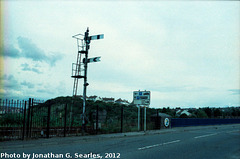
2012
Looking back on 2012, I assumed that it had been a much busier year than many in the past. However, bizarrely, this is also the year in which I have, since 2006, posted the fewest photos online. I can't account for this, other than to say that I probably didn't take as many photos proportionally to what I was doing. You can see from the wide range of subject matter that I actually did quite a l…
(read more)
Massey's Electric Log, S.S. Great Britain, Bristol…
| |
|
Another extremely advanced technology on the S.S. Great Britain, like something out of Jules Verne (but long before he was writing), was this electric log. The turbine on the right was dragged in the water, turning a cable in a tube, and the instrumentation then serves as an odometer, maintaining accuracy over thousands of nautical miles. The instrumentation was supposedly not connected directly to the cable, but rather by electricity, making the engineering challenge arguably greater for the time.
Massey's Electric Log on the S.S. Great Britain, P…
Massey's Electric Log on the S.S. Great Britain, P…
| |
|
Here are the exposed leads where the log was connected to the ships electrical system (such as it was).
First Class Quarters on S.S. Great Britain, Bristo…
| |
|
Here's an alternate shot of the first deck down, looking towards the stern (the other photo was looking forward).
Navigation Room on S.S. Great Britain, Bristol, En…
Whistle from S.S. Great Eastern, Bristol, England…
| |
|
Brunel's largest and most famous ship was, of course, not the S.S. Great Britain, but the S.S. Great Eastern, which when built in 1859 was the largest in the world, following in the tradition of the Great Britain. However, it was so large that it was very hard to fill it (it could carry up to 4,000 passengers), making it uneconomic. It's most significant achievement was probably the laying of the first successful transatlantic cable in 1866 (although earlier attempts had been made). In spite of its historical significance, however, it was scrapped in 1889. It was so well built that it took until 1890 to finish the scrapping. I was unaware until this trip what parts of it had been saved, and was very surprised to find the whistle displayed in the S.S. Great Britain museum. It's connected to an air compressor, but as anyone familiar with steam power will know, this doesn't properly replicate the sound.
Part of Funnel from S.S. Great Eastern, Bristol, E…
| |
|
This is what's left of one of the S.S. Great Eastern's funnels. Supposedly it survived because it was used in a factory.
Rolls Royce/SNECMA Olympus 593 Jet Engine from the…
| |
|
For some odd reason, someone got the idea to preserve this jet engine from the Concorde supersonic transport in the S.S. Great Britain's museum, complete with a video of the Concorde's test flight. The only real connection between the two is that both the S.S. Great Britain and the Concorde were built and tested near Bristol, and Rolls Royce, a contractor that worked on this engine, also helped to build the reproduction engines now in the Great Britain. It might have been just a funding issue. Someone got this engine, and had to find a place to keep it. The display plaque calls the S.S. Great Britain the "Concorde" of its day, but actually the Great Britain, while fast, was not the fastest ship in the world. A better aviation comparison would be with the Airbus A380, as the Great Britain WAS the biggest ship of its day.
Toilets from S.S. Great Britain, Bristol, England…
| |
|
These toilets have elaborate enamel work on them, but are interesting more for how modern they look, in spite of the overdone decorations. Obviously, they're original, and quite beat up. I presume they were found in the collapsed decks in 1970. Supposedly, one toilet on the ship was tested at the time and found to still work, although presumably it wasn't either of these.
Steam Tug Mayflower, Bristol, England (UK), 2012
| |
|
|
A much smaller steam-powered vessel in Bristol is the Mayflower, built in May of 1861. To put that in perspective, the U.S. Civil War had only been going on for one month. Britain would side with the Confederacy, at least unofficially, and temporarily. That's a whole story in itself. In spite of its name, though, the Mayflower had no connection to America. More impressive was that it served for 103 years, until 1964!!! It didn't wear out, either. It still runs today, although only for tourists. It wasn't under steam when I was there, but it had run recently. The stern claims it was or is based in Gloucester, probably because it was originally built for the Gloucester and Sharpness Canal. For most of its career, though, it served primarily right here, in the Bristol Channel. In fact, it probably helped to push the S.S. Great Britain at some point. However, the engine was replaced in 1899, soon after it was moved to the Channel, so the engine used today, while old, isn't really a genuine 1861 steam engine.
Bristol Docks Railway, Edited Version, Bristol, En…
| |
|
Like most ports, Bristol acquired extensive rail connections in the 19th Century, and many if not most of these remain today. Much of it is ex-Great Western, as Great Western controlled most of the original rail services in and out of Bristol. Even the Bristol & Exeter was eventually taken over by them. However, due to the port's decline (with much of this having to do with its inability to take the largest, newest ships), these rail lines have either become dormant or been included in the Bristol Docks Railway, a steam tourist railway that uses the lines into the port. When I visited, I didn't catch a train in steam, but I found some of the equipment in the yard. Unlike most rail facilities in the developed world, tourists and trains have to share some of the same space, as several of the tracks are embedded into the pavement of docks that are now pedestrianised for tourism. As a result, although I didn't spot any moving trains, I was constantly looking over my shoulder. I was standing on the tracks here, for example, but in the pedestrian area.
Bristol Docks Railway, Picture 2, Edited Version,…
| |
|
My sense was that the tourist rail route went back into the woods, but came out somewhere else. In any case, this line was clearly not open to the public, so I didn't follow it. Again, I was standing here in the pedestrian area.
Bristol Docks Railway, Picture 3, Edited Version,…
| |
|
There was quite a lot of preserved freight equipment in the yard, here you can see a freight van on the right (a boxcar in American terms), a brake van (equivalent to a caboose), and a gondola. You can see some of the embedded track in the foreground.
Crane on Bristol Docks, Edited Version, Bristol, E…
| |
|
The Bristol Docks Railway's embedded track goes pretty much all the way into the port, and you can see a tiny bit of it on the right. I took this photo, however, to document that steam crane in the middle. It hasn't been used since this part of the port was deactivated about 40 years ago, but it still runs and is steamed on special occassions.
Bristol, Edited Version, England (UK), 2012
| |
|
This was the only generic shot of Bristol that I chose to upload this time. Here you can see the Bristol Channel, some of the boats docked in it, and St. Mary Redcliffe Church, which actually has a higher steeple than the Bristol Cathedral.
Bristol Temple Meads Station, Picture 2, Edited Ve…
| |
|
Although I was an avid railfan when I lived in Britain, I rarely visited Temple Meads until recently. Now I go there regularly when I'm in Britain. This is the front entrance, with the taxi rank. The station dates to the days of the GWR, although as far as I know it isn't original. Although the site dates back to 1840, most of the present station dates to 1870, when it was redesigned by Francis Fox to accomodate more traffic.
Bristol Temple Meads, Picture 3, Edited Version, B…
| |
|
Temple Meads is frequently used for charters, steam excursions, and so on, so it's not uncommon to see steam-era coaching stock there. This train appears to be either ex-Great Western or BR Mk.I, but with Western Region livery. In truth, BR Mk.I stock was based on the designs used on the private railways in 1947, so it's often hard to distinguish from genuine pre-1948 stock without a careful examination. One way or another, this is BR Western Region livery rather than GWR livery.
Semaphores on Barry Island, Edited Version, Glamor…
| |
|
These are the semaphores controlling the branch line to Barry Island. Traditional semaphores like these, often connected to mechanical interlocking systems controlled by telegraph, while increasingly rare, can still be found throughout Britain. In contrast, the branch to Barry is one of the newest in Britain, or at least one of the last to have been built in the steam era (newer light and high-speed rail projects are another story, of course), having been completed in 1896. Prior to the line's construction, there had been no road access, although as you can see there's road access now. Barry Island is primarily a seaside resort, although when I was there it seemed smaller than in fact it is. This was probably because I wasn't very interested and didn't walk around much.
Jump to top
RSS feed- Latest items - Subscribe to the latest items added to this album
- ipernity © 2007-2024
- Help & Contact
|
Club news
|
About ipernity
|
History |
ipernity Club & Prices |
Guide of good conduct
Donate | Group guidelines | Privacy policy | Terms of use | Statutes | In memoria -
Facebook
Twitter


















